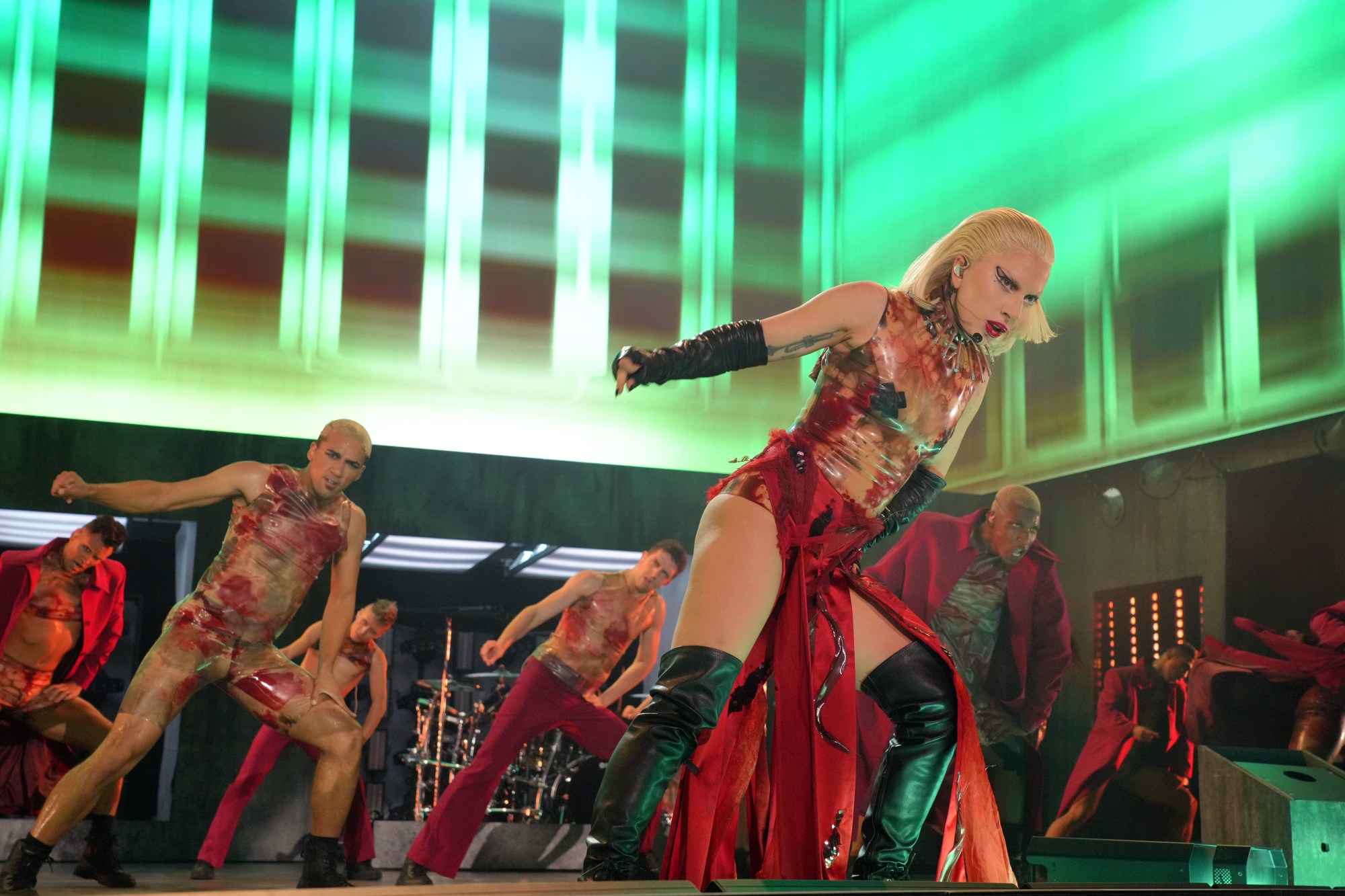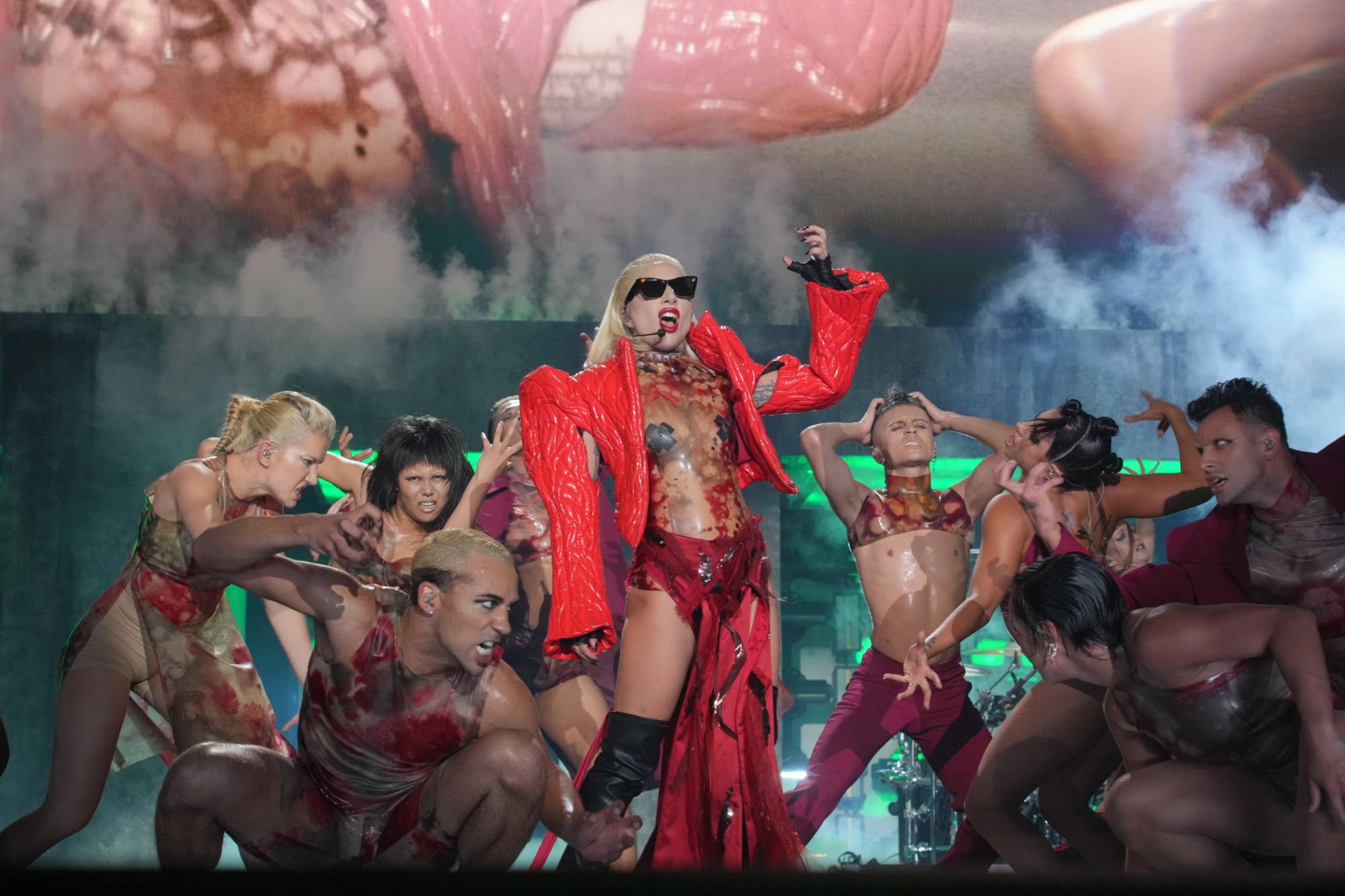The music stops, and from it swells two things: a sea of ear-splitting applause and the laboured breath of a pop star willing to sacrifice everything for her audience. Lady Gaga, arguably the most dedicated and, still, provocative pop star of her generation, lets you hear it: the sharp intakes and exhales, the mark of a marathon-level musical icon.
Lady Gaga has a desire to impress people, not satisfied by the banal or mediocre. It’s been over four years since she last toured an album, 2016’s Joanne, but the show was mired by setbacks and cancellations, as a consequence of her suffering from Fibromyalgia. It’s a chronic pain condition that made the very thing that makes her a star — leaning into pop’s theatrics, dancing and singing in elaborate acts — agonising. It’s always felt like something of a bodily betrayal: a once-in-a-generation talent battling back against her own biology. But the idea of half measures is of no interest to her: it may hurt, but still, she’s willing to throw every morsel of her energy into making shows as miraculous as the Chromatica Ball.
The result is her most macabre, profound and personal show to date. The Chromatica Ball, a highly anticipated stadium tour with just 20 dates compared to the Joanne Ball’s 49, shortens the tour’s span and permits her breaks between shows to recover properly. It’s a move that ensures each one will land like a lit firecracker in stadiums across Europe, America and Asia from now until September.

The live Lady Gaga show has always been a momentous event, steeped in allegory beneath neon lighting and jaw-dropping set design. She’s brought meaning to her music where few cynics assumed it was possible: made a sleazy New York freak show with her sophomore tour The Monster Ball; built whole castles and transformed into motorcycles for the Born This Way Ball. Though bells and whistles have long been her thing, the surprisingly barren set of the Chromatica Ball tour acts as a brutalist, foreboding canvas for her deeply introspective ideas.
It makes sense in the context of Chromatica musically: her number one album, which dropped in 2020 weeks into the pandemic, disguised the malaise of her personal life — heartbreak, anxiety, dependency — under the widescreen dance beats of producer Bloodpop. “If you’re in pain and listening to this music, just know that I know what it’s like to be in pain,” she told Paper around its release. “And I know what it’s like to also not let it ruin your life.”
That second statement is significant when picking apart the Chromatica Ball and what it represents.

It is staged like an almighty career retrospective; the stage akin to a gallery space where spectators observe her radio-leaning pop songs through a lens of performance art. It’s broken into an epilogue, four acts and a finale, each one accompanied by an interlude directed by longtime collaborator Nick Knight. But each feels tonally different from the last: an insect-like Gaga, dressed in Gareth Pugh, silhouetted like a flesh-eating savage is the central focus in one; later, she’ll be adorned in flowers and bejewelled, bare-faced. While the Chromatica era’s artwork and music videos were defined by a kind of Power Rangers, turbo-technicolour feel, The Chromatica Ball’s staging is sapped of all colour: stark and grey. “Inspired by brutalist architecture… ” Gaga said. “… materials, textures, crudity, transparency. A real savage and hard look at yourself, what you’ve been through.” Instead, we witness Gaga’s metamorphosis into characters from her past. During “Poker Face”, for example, a 3D rendering of the Nick Knight statue for her 2010 Brits tribute to Alexander McQueen flashes on screen in gumball red. When she performs “911”, she wears the kind of Berlin leather garb that felt prescient during the Born This Way era. In some ways, it’s like all of these characters stir inside of her still.
She opens with her three biggest hits back-to-back – “Bad Romance”, “Just Dance” and “Poker Face” – performed from within a cocoon-like structure that, piece by piece, falls away, like a metaphor for the prison of success and public expectation. It’s a symbol of her audacity: her ability to get three massive crowdpleasers out of the way before the shows even begun.
Her imprisoned pop section is followed by her savage sacrifice: “Alice” is performed on a floating operating table before she drops to sing “Monster”, where she’s shrouded by her dancers and emerges in a crimson jacket with padded shoulders and sunglasses, like a character from her The Fame Monster era.

The fashion credits are plentiful too, both custom and archive: moiré gold capes and suits for “Babylon” and a leather studded biker jacket, courtesy of Alexander McQueen. A handful of custom and archive Gareth Pugh looks appear too, a throwback to her “Bad Romance” performance on The X Factor.
The sacrifice leads, of course to her rebirth: a “Free Woman” wandering through her crowd in the McQueen moiré as her dancers vogue around her. Even her extensive piano section – where she delivers “Shallow”, “The Edge of Glory” and a stripped back live debut of “1000 Doves” feel healing, even as she incongruously appears dressed as a praying mantis.
By the time we reach the pyrotechnic-filled final act, marked by the punch of “Stupid Love”, Gaga pushes her voice further, the effort paying off with her immense vocal belts, laying it all out on stage. Those pants from her radio mic continue as she lays on the floor of the stadium’s stage, before effortlessly jumping into a pitch perfect “Rain On Me”.
Pain and sadness are seldom seen as fuel for major stadium pop shows, but Lady Gaga’s Chromatica Ball makes art both brutal and glossy from them. To bear witness to it is to see Lady Gaga both channel it, and for two euphoric hours, put it to bed: this is her most profound stage statement yet.

Tickets for Lady Gaga’s The Chromatica Ball stadium shows are on sale via Live Nation now.

